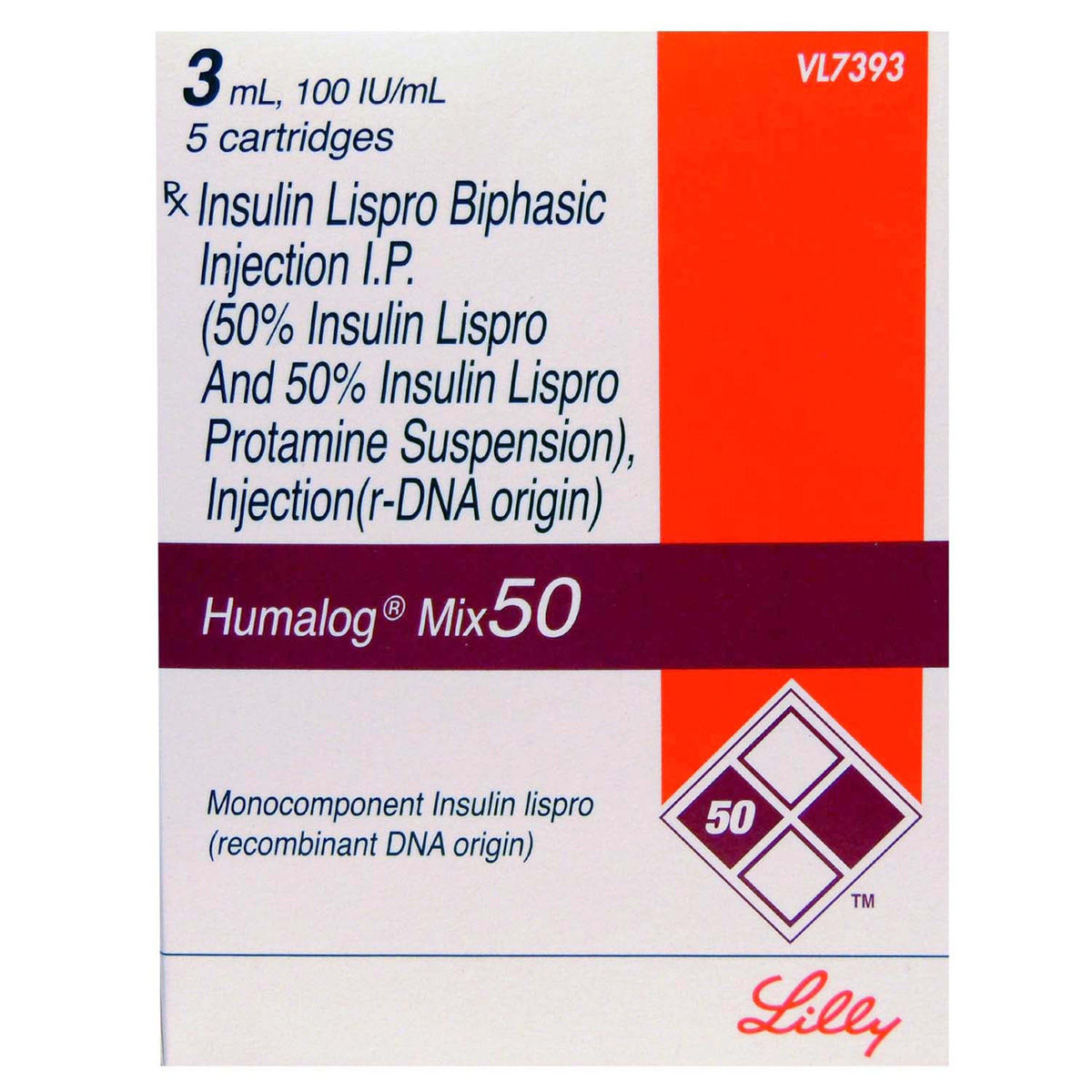Insulin Lispro+insulin Lispro Protamine
About Insulin Lispro+insulin Lispro Protamine
Insulin Lispro+insulin Lispro Protamine is used to treat type 1 and type 2 diabetes mellitus. In diabetes mellitus type 1, the body does not produce enough insulin to regulate blood sugar levels (glucose). On the other hand, in diabetes mellitus type 2, either the body stops producing enough insulin (the hormone which helps decrease sugar levels in the blood) or there is resistance to the action of insulin. As a result, insulin is produced in large amounts, leading to high blood glucose levels.
Insulin Lispro+insulin Lispro Protamine contains Insulin lispro and insulin lispro protamine. Insulin lispro is fast-acting insulin, whereas Insulin lispro protamine is an intermediate-acting insulin. Insulin Lispro+insulin Lispro Protamine suppresses the production of sugar in the liver and facilitates the reuptake of sugar in the fat and muscle cells; thereby, Insulin Lispro+insulin Lispro Protamine ensures rapid and consistent sugar control.
Your doctor will advise you on how to use the Insulin Lispro+insulin Lispro Protamine. In some cases, you may experience hypoglycemia (low blood sugar), itching, mild rash, and injection site reactions like redness or swelling. Most of these side effects of Insulin Lispro+insulin Lispro Protamine do not require medical attention and gradually resolve over time. However, if the side effects are persistent, reach out to your doctor.
Insulin Lispro+insulin Lispro Protamine is recommended for use by anyone under the age of 18. Consult your doctor before taking Insulin Lispro+insulin Lispro Protamine if you are pregnant or breastfeeding. Insulin Lispro+insulin Lispro Protamine may cause hypoglycemia, so drive only if you are alert. Avoid alcohol consumption along with Insulin Lispro+insulin Lispro Protamine. Keep your doctor informed about your health condition and medications to rule out any interactions. Insulin Lispro+insulin Lispro Protamine is a cold chain medicine. It has to be stored in the refrigerator between 2-8°C else its efficiency may be lost. Do not store in the freezer.
Uses of Insulin Lispro+insulin Lispro Protamine
Medicinal Benefits
Insulin Lispro+insulin Lispro Protamine belongs to the class of medications called ‘antidiabetics’ primarily used to improve blood sugar control in adults with diabetes mellitus. Insulin Lispro+insulin Lispro Protamine is a combination of Insulin lispro and insulin lispro protamine. Insulin is a hormone that works by lowering glucose levels (sugar) in the blood. Insulin lispro is fast-acting insulin. Insulin lispro protamine is an intermediate-acting insulin. Insulin Lispro+insulin Lispro Protamine suppresses the production of sugar in the liver and facilitates the reuptake of sugar in the fat and muscle cells; thereby, Insulin Lispro+insulin Lispro Protamine ensures rapid and consistent sugar control. Insulin Lispro+insulin Lispro Protamine helps prevent the chances of developing serious complications of diabetes, like damage to the retina (retinopathy), damage to the kidney (nephropathy), damage of nerve cells (neuropathy), diabetic foot ulcer, and various complications occurring due to diabetes. Insulin Lispro+insulin Lispro Protamine starts to work within 10 minutes after injection, peaks in 2 hours and keeps working for up to 24 hours. Thereby it controls and maintains the glucose levels in the body throughout the day.
Directions for Use
Storage
Side Effects of Insulin Lispro+insulin Lispro Protamine
Hypoglycaemia (low blood sugar level)
Injection site reactions
Itching
Rash
Drug Warnings
If you are allergic to any of the contents of Insulin Lispro+insulin Lispro Protamine, please inform your doctor. Insulin Lispro+insulin Lispro Protamine is not approved for use by anyone under 18. Before taking Insulin Lispro+insulin Lispro Protamine, tell your doctor if you have ever had liver/kidney disease or low potassium levels in your blood (hypokalemia). Consult your doctor before taking Insulin Lispro+insulin Lispro Protamine if you are pregnant or breastfeeding. Drive only if you are alert as Insulin Lispro+insulin Lispro Protamine may cause hypoglycemia. Avoid alcohol consumption along with Insulin Lispro+insulin Lispro Protamine. Insulin Lispro+insulin Lispro Protamine is a cold chain medicine, and it should be stored in a refrigerator between 2-8°C; otherwise, it may lose its effectiveness. Do not freeze. Keep your doctor informed about your health condition and medicines to rule out any side effects.
Drug Interactions
Drug-Drug Interactions: Insulin Lispro+insulin Lispro Protamine may have an interaction with antidiabetics (e.g. pioglitazone), thyroid hormones (e.g. levothyroxine), blood pressure-lowering medicines (e.g. metoprolol, hydrochlorothiazide, irbesartan, candesartan), bronchodilator (e.g. metaproterenol), pain killer medications (e.g. aspirin), and anti-depressant medications (e.g. sertraline).
Drug-Food Interactions: Avoid alcoholic beverages with Insulin Lispro+insulin Lispro Protamine as it may increase or decrease your blood sugar level.
Drug-Disease Interactions: Inform your doctor before taking Insulin Lispro+insulin Lispro Protamine if you have or ever had kidney disease, hepatic impairment or liver disease, hypoglycemia (low blood sugar), and hypokalaemia (low potassium level).
Drug-Drug Interactions Checker List:
Safety Advice

Alcohol
unsafeYou are recommended not to consume alcohol along with Insulin Lispro+insulin Lispro Protamine to avoid unpleasant side effects.

Pregnancy
safe if prescribedIt is safe to use Insulin Lispro+insulin Lispro Protamine during pregnancy if prescribed by the doctor. However, consult your doctor if you have any concerns regarding this.

Breast Feeding
safe if prescribedIt is safe to use Insulin Lispro+insulin Lispro Protamine by breastfeeding mothers if prescribed by the doctor. However, consult your doctor if you have any concerns regarding this.

Driving
cautionInsulin Lispro+insulin Lispro Protamine may cause hypoglycemia (low blood sugar). Therefore, drive only if you are alert.

Liver
cautionInsulin Lispro+insulin Lispro Protamine should be taken with caution, especially if you have a history of liver diseases/conditions. The dose may have to be adjusted by your doctor.

Kidney
cautionInsulin Lispro+insulin Lispro Protamine should be taken with caution, especially if you have a history of kidney diseases/conditions. The dose may have to be adjusted by your doctor.

Children
cautionInsulin Lispro+insulin Lispro Protamine is not approved for use by anyone under the age of 18.
Habit Forming
Diet & Lifestyle Advise
Take short, frequent meals. Avoid prolonged fasting.
Beware of hypoglycaemia symptoms such as sweating, dizziness, palpitations, shivering, intense thirst, dry mouth, dry skin, frequent urination, etc. Whenever you experience the mentioned symptoms, immediately consume 5-6 candies or three glucose biscuits or three teaspoons of honey/sugar and get in touch with your physician. Make sure to carry these with you at all times, especially for long travels.
Avoid drinking alcohol. It increases the risk of hypoglycaemia (decrease in blood sugar which might be fatal in some cases) and lactic acidosis (when the lactic acid increases in the body, which impacts various organs).
Try to quit smoking.
Reduce intake of carbohydrate-rich food like potato, rice, mangoes, bread, sugar, etc.
Avoid eating sugary food and prefer food low in calories.
When travelling across more than two time zones, you should talk to your doctor concerning adjustments in your insulin schedule.
Special Advise
Your doctor may tell you to have regular potassium level tests as Insulin Lispro+insulin Lispro Protamine may cause hypokalaemia (low potassium).
You should normally inject Insulin Lispro+insulin Lispro Protamine within 15 minutes of a meal.
Always use a new sterile needle for each injection.
Patients Concern
Disease/Condition Glossary
Type 1 diabetes mellitus: In type 1 diabetes mellitus, the body does not make insulin (the hormone that helps decrease sugar levels in the blood) to control blood sugar levels.
Type 2 diabetes mellitus: In type 2 diabetes mellitus, either the body stops producing enough insulin or there is resistance to the action of insulin. As a result, insulin is produced in sufficient amounts but cannot act on the tissues of the organs.
FAQs
Insulin Lispro+insulin Lispro Protamine is used to treat type 1 and type 2 diabetes mellitus.
Insulin Lispro+insulin Lispro Protamine suppresses the production of sugar in the liver and facilitates the reuptake of sugar in the fat and muscle cells, thereby Insulin Lispro+insulin Lispro Protamine ensures rapid and consistent sugar control.
You should inform your doctor before travelling especially when travelling to a different time zone as a dose adjustment may be required.
Hypoglycemia refers to low blood sugar levels. Insulin Lispro+insulin Lispro Protamine may cause hypoglycemia. The symptoms of hypoglycemia include nausea, headache, irritability, hunger, sweating, dizziness, fast heart rate, and feeling anxious or shaky. Hypoglycemia can occur if you miss or delay your food, drink alcohol, over-exercise, or take other antidiabetic medicine along with Insulin Lispro+insulin Lispro Protamine. Therefore, it is important to monitor blood sugar levels regularly. People with diabetes are advised to keep a quick source of sugar like glucose tablets, chocolate, glucose biscuits, honey, or fruit juice with them. If you experience any of the symptoms of hypoglycemia, consult your doctor.
In some cases, Insulin Lispro+insulin Lispro Protamine can lower the potassium level, leading to a state of hypokalaemia. You may feel dizziness, thirst, and general weakness in this case. So, it is advisable to have regular blood sugar and potassium level check-up.
Do not stop taking Insulin Lispro+insulin Lispro Protamine without consulting your doctor on your own as it may cause an increase in blood glucose levels. Continue taking Insulin Lispro+insulin Lispro Protamine for as long as your doctor has prescribed it to you. Do not be reluctant to speak with your doctor if you experience any difficulty while taking Insulin Lispro+insulin Lispro Protamine.
You are recommended to avoid white bread, maida, poori, naan, noodles, biryani, fried rice, corn flakes, cheese, ice creams, milkshakes, beef, pork, sugarcane juice, soft drinks, sweetened health drinks and beverages. Also, avoid mango, seetaphal, jack fruit, fruit salads with ice cream, and fruit-based desserts.
Taking injection at the same site may cause local irritation, itching and lump formation. Therefore, it is best to avoid taking injections at the same site or maintain a gap of at least one day.
Maintain a diet that includes chapatis, puffed rice with vegetables, multigrain bread, plain cooked dal, roasted grams soups, sprouts, cooked vegetables with less oil, steamed vegetables, orange, jamun, guava, watermelon, apple, papaya, curd, cow’s milk, thin buttermilk, fish (baked, grilled, or steamed), cashew nuts, peanuts, and walnuts (handful). Avoid alcohol consumption and quit smoking. Exercise regularly and brisk walk daily for 30 minutes. Also, limit intake of sugar.
The risk factors for developing low blood sugar levels include not taking adequate meals or skipping meals, excessive insulin use, too much alcohol intake, fever and too much exercise. Some medications, like other diabetes medicine glimepiride, medicines used for fever and pain (salicylates), ramipril, etc., can result in such episodes when used with insulin. Inform your doctor about these episodes as you may need dose adjustment.
Before injecting, wash your hands. Select the injection site. Clean the skin as advised. Remove outer needle cap. Spread the skin or pinch up a large area to stabilize the skin. Insert the needle as instructed. Press the knob. Remove the needle out and apply gentle pressure over the injection site for several seconds. Do not rub the area. Dispose of the needle safely by unscrewing it using the outer needle cap. Injection sites should be used alternately so that the same site is not used more than approximately once a month.
Rotate the insulin device in the palms of your hands ten times and invert it 180° ten times immediately before use to resuspend the insulin until it appears uniformly milky or cloudy. If not, repeat the previous steps until contents are mixed. Avoid shaking vigorously as it may cause frothing which may interfere with the correct measurement of the dose. The cartridge/ device should be examined frequently and not be used if solid white particles stick to the bottom or wall of the cartridge, giving a frosted look or if clumps of material are present.
Yes, you must prime your pen. If you do not prime, you may receive too little or too much insulin. For priming, turn the dose knob to 2 units. Hold the pen with the needle pointing up. To collect air bubbles at the top, gently tap the cartridge holder. Continue holding your pen with the needle pointing up. Push the dose knob in until it stops and '0' appears in the dose window. Hold the dose knob in and slowly count to 5. Insulin should be visible at the tip of the needle.
To make it easier to inject, push the dose knob of the pen more slowly. It is possible that your needle is blocked. Replace the needle with a new one and prime the pen.
The side effects of Insulin Lispro+insulin Lispro Protamine include hypoglycaemia (low blood sugar), injection site reactions, rash and itching.
If you are experiencing any side effects, please inform your doctor.
Medications with hyperglycemic activity (drugs that increase glucose levels) such as isoniazid, corticosteroids, certain lipid-lowering drugs (e.g., niacin), oral contraceptives, estrogens, phenothiazines, and thyroid replacement therapy may increase the insulin requirement.
Insulin requirement may be decreased by drugs that increase insulin sensitivity or have hypoglycemic (blood sugar lowering) activity, such as oral antidiabetic agents, sulfa antibiotics, salicylates, angiotensin-converting-enzyme inhibitors, certain antidepressants (monoamine oxidase inhibitors), beta-adrenergic blockers, angiotensin II receptor blocking agents, inhibitors of pancreatic function (e.g., octreotide), and alcohol. In some patients, the symptoms of hypoglycemia (low blood sugar) may be masked by beta-adrenergic blockers.
Insulin Lispro+insulin Lispro Protamine should be used with caution during pregnancy and lactation (breastfeeding). Follow your doctor’s instructions carefully.
Available Medicines for
Insulin Lispro+insulin Lispro Protamine

Eglucent Rapid Kwikpen 100Iu/ml Injection 3 ml
1 Prefilled Syringe
₹1119.6 (MRP 1244)10%Off
cashback: 0









